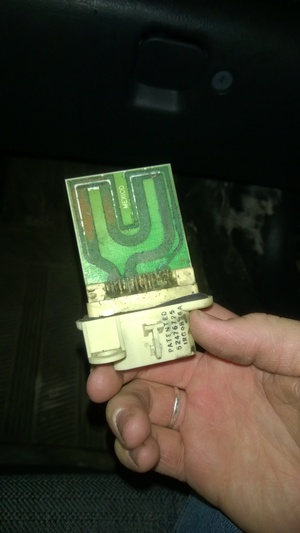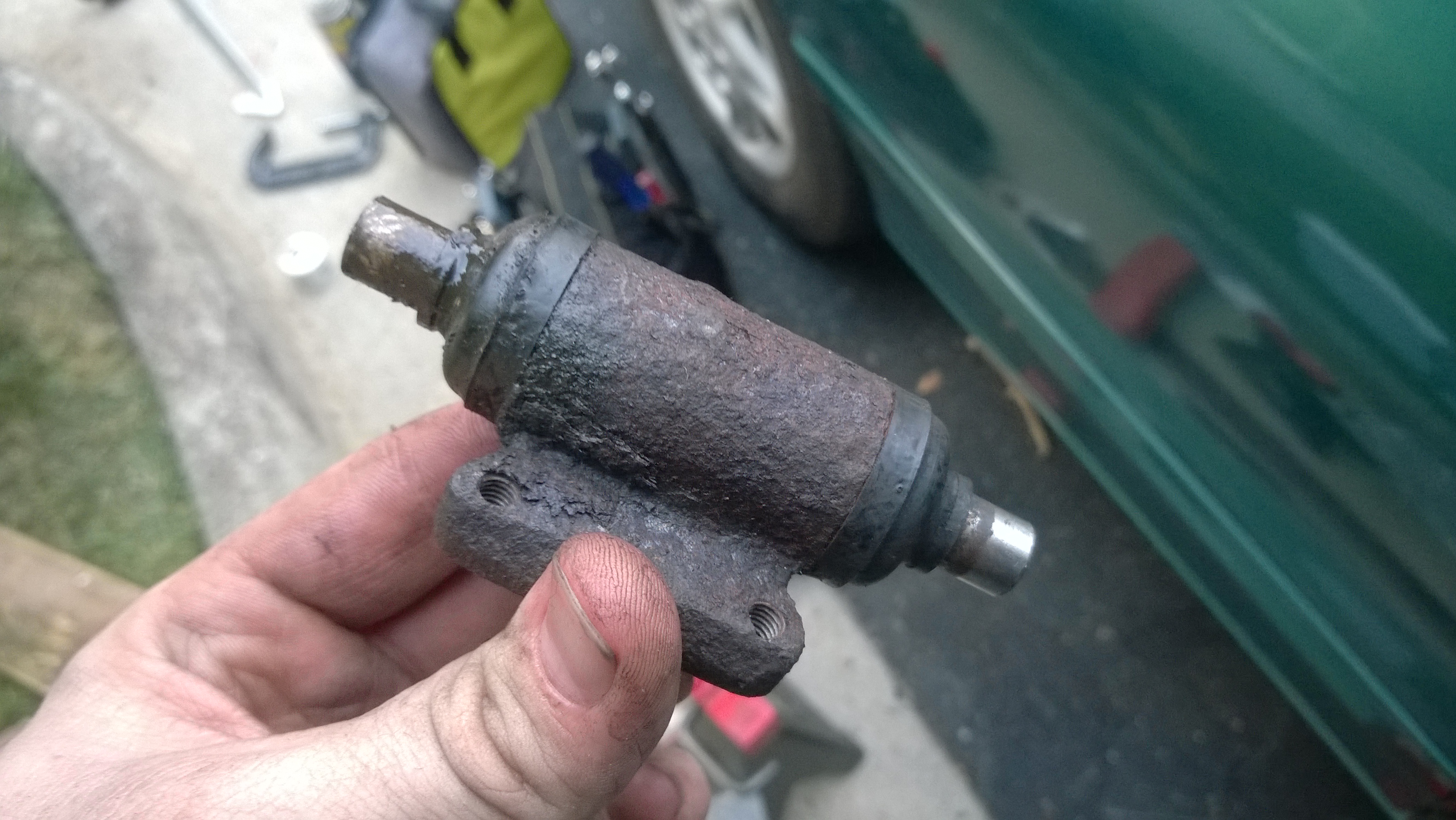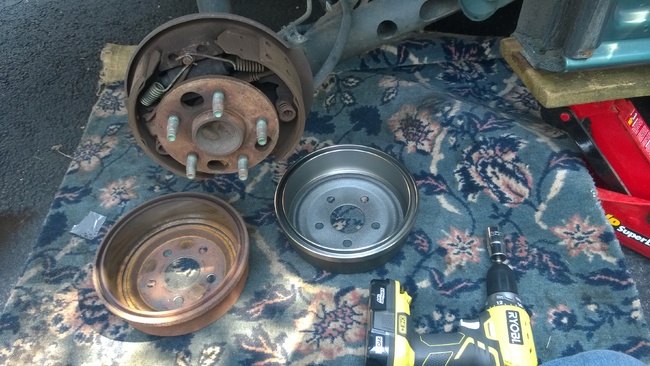Leadfoot: Them's the Brakes
 Tuesday, September 15, 2015 at 2:47PM
Tuesday, September 15, 2015 at 2:47PM Another of those everyday annoyances I just learned to deal with was the brakes. Some days were worse than others, but an imbalance in either the front or rear brakes meant there was a pulsation when applying the go-slower pedal that changed its frequency linearly relative to vehicle speed.
In my ignorance, I’d first thought it was the anti-lock brake system doing its on-off thing. So shoot me, it was seven years ago and I’d never had a car with ABS before.
But then the ABS light started coming on. It wasn’t always on, I just noticed it more during inclement weather, so in my ignorance (again), I assumed this meant the system was working extra-hard. No, I have no clue where I got this idea.
Later I learned that an ABS light means you don’t have ABS. I found this out after an event on the interstate forced me to use some heavy braking. I felt the rear of the car come loose and saw white tire smoke behind me. Once I’d gotten clear of the Darwin Award candidate who decided to cross three lanes to get away from an exit, I thought to myself, “The rear brakes must have locked up when the weight shifted forward. …But the brakes shouldn’t have locked up, because my ABS light is on, and that means the system’s work… oh.”
Supposedly, there’s a way to use the light to diagnose what the problem is, exactly. I was never able to figure out how to do that, but investigation found it to be a faulty wire from the combination of oil leaks and front-end collision I mentioned earlier. All of this meant the anti-lock brake system had nothing to do with the pulsation in braking power.
So it must be the brakes. I couldn’t feel the pulsation in the pedal, and the steering wheel didn’t pull, so it must be the one of the rear drums that’s out of round. Imagine you’ve put all your laundry in one side of your top-loading washing machine. Once it gets to the spin cycle, the machine is going to start doing the Jitterbug all around the laundry room. And that’s not going to be fun for anybody, because nobody knows how to do the Jitterbug anymore.
Because of the imbalance, passenger comfort requires effort on my part. Coming from highway speeds, a light touch of friction brings me down to where I can downshift into second. The brakes even out a bit and I can apply more pressure, but then I have to ease back off and modulate with the pulsation, lest my guest become an inadvertent head-bobber.
So the drums need replacing.
The parts are ordered and on the way when I find the HVAC fan only works on speeds three and four. The blower resistor has gone bad. As summer comes to a close, this is problematic. In the mid-Atlantic, summers get brutal with heat and humidity, and Eddie has zero tint on his windows. So from late May to early September, I’m quite content to leave the air conditioning on a higher speed. Keeps me cool, because the sun’s rays have little barrier to entry.
But as the Earth continues its orbit, we start to lose the heat, but keep the humidity until November. Now imagine that humidity combined with the greenhouse effect of a car with no tint. It all equals an uncomfortable drive for me (a man who prefers the cold) until I introduce the cooling and drying effects of air conditioning. And without the outside heat as a contributing factor, fan speed three is just too cold (even for me). But a bad blower resistor means that’s the lowest speed I’ve got.
The Internet is a great thing for what it can be. Yes, we use it to send pictures of our genitals to strangers who don’t want them, but beyond the dick pics, lunch tweets, and clickbait is an immense hoard of information that’s already indexed for immediate access. I typed into Google, “Pontiac Sunfire blower motor resistor,” and right below some shopping results were two tutorial videos on YouTube on how to replace the part. One of them even went so far as to advise on how best to orient yourself in the car when accessing the deepest recesses of the passenger footwell.
 Was it difficult to get to? No. It was impossible. I had to remove the blower to make it difficult.
Was it difficult to get to? No. It was impossible. I had to remove the blower to make it difficult.
I was thankful for my cordless drill and U-joints. I’d managed to get one of the bolts out using my smallest of ratchets in this most claustrophobic of space, but the back-and-forth motion combined with the flexibility of the U-joint meant the socket kept coming off the bolt head. Relief came from the constant rotational force of the electric motor in my lime-green drill.
And while the blower was out, I cleaned out the dead leaves. Now, with the new resistor and a clean blower I’ve got all my fan speeds and they work better than they did before they stopped working.
This I did while laying upside-down on the reclined passenger seat, my feet right about where a rear passenger’s ears would be. Actually, someone sitting there would have been helpful, so I wouldn’t have to fumble blindly for the right socket extension from the half-dozen I’d stowed in the cup holder.
Back down at my parents’ house with brake parts from the Internet, I pulled the rear wheels and hammered off the brake drums.
I’ve never been a fan of drum brakes. So many different parts, all needing to work together to achieve the same result as squeezing two pads on a disc brake. Every time I’ve had to replace something, I take a dozen pictures with my phone to reference how everything goes back together. And I always miss something in the pictures, so I’m at a loss with that one bit during reassembly, leaving me stabbing at straws until the springs are able to hold everything together tight enough to fit the drums back on.
About the time I’m about to clamp the new shoes in, Dad comes out and notices a leak in the brake cylinder.
That’s bad. Like, “need to replace it now before the problem’s even bigger” bad. YouTube showed me how bad it could possibly be when I’d asked the Clarksonion Rhetorical.
 YouTube was also helpful when it came to removing the cylinder. The brake cylinder on a GM J-Body is one of those parts that’s put on before attaching the wheel hub. This makes it difficult to remove almost on the same level as the blower resistor. Thankfully, there’s a nice Canadian fellow with a liking for lock pliers who will show you how to remove it with a lot of hammering and a long screwdriver.
YouTube was also helpful when it came to removing the cylinder. The brake cylinder on a GM J-Body is one of those parts that’s put on before attaching the wheel hub. This makes it difficult to remove almost on the same level as the blower resistor. Thankfully, there’s a nice Canadian fellow with a liking for lock pliers who will show you how to remove it with a lot of hammering and a long screwdriver.
Once again, Eddie shows up in the neighborhood, here comes the sound of hammering steel.
Dear General Motors: In my experience, a wheel cylinder is more likely to need replacing than the wheel hub. Why would you not make the former easier to remove without first taking off the latter?
Their answer, apparently, is to equip the wheel hub with a hole on one side. This (theoretically) allows enough room to rotate the cylinder until it can be maneuvered free of its prison. But even with this “room,” it still took considerable hammering and prying to liberate the leaky little bastard.
And it took even more hammering and wedging to shoehorn in its replacement. This is all while brake fluid is dripping into an ever-expanding puddle. And the fluid is such a lovely shade of ink-black. That’s because I’ve never flushed the brake system. I need to do that soon as I get the appropriately-sized plastic tubing. There’s a plan in my head for that.
And after that headache, putting the new shoes on was the part I’d been dreading. Imagine a jigsaw puzzle, but none of the pieces fit until you put it all together. Then the shoes need extra hammering to get into place because the holding springs won’t do that job by themselves. Even when all the pieces are in place, the shoes kind of float around, contained only by the drum, so they need tapping into place so the drum can fit around them and line up with the wheel studs.
With the wheels back together, I rolled Eddie’s front wheels up onto ramps to drop the transmission pan again to replace the filter I should have replaced before. That went well.
Not so much trying to replace the spark plugs. The number four plug is possibly cross-threaded.
And I admitted defeat with trying to replace the alternator, which feels ready for retirement. But while I was able to pop the end of a serpentine belt remover into the appropriate 3/8” socket built into the tensioner, the arrangement of the engine bay was such that I didn’t have enough room to sufficiently loosen the belt. I could have gotten creative, but the day was long enough and I put it, too, aside.
So at the end of it all I’ve got a less-effective handbrake and the pulsation can now be felt more in the pedal than the body of the car. So I accomplished nothing I set out to do and only succeeded in preventing a bigger problem.
Not my most productive day. But the Eddie runs enough to trek 400 miles each way for my vacation. I’ll just keep my tools in the trunk when I head out.
 Clarkson Rhetorical,
Clarkson Rhetorical,  Leadfoot,
Leadfoot,  Pontiac,
Pontiac,  Sunfire,
Sunfire,  auto repair,
auto repair,  brake fluid,
brake fluid,  brakes,
brakes,  hammering,
hammering,  transmission,
transmission,  wheel cylinder | in
wheel cylinder | in  LeadFoot
LeadFoot 
